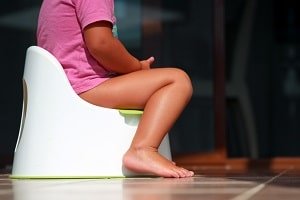
Potty training is easier when parents plan ahead. Here’s a potty training checklist of things to do before you begin.
1. Consider your child’s age
Parents can safely begin training at a variety of ages, but your goals should match the developmental level of the child.
For an overview, see this article about deciding when to start and how to proceed. It will help you set realistic expectations for what you and your child can achieve.
Worried that your child is too young? See this review of what scientific studies say about the timing of toilet training.
2. Help your child prepare for potty training
Things may go more smoothly if you child knows what to expect. Review theseguidelines for preparing your child.
3. Decide which technique(s) are right for your child
These may vary depending on the age and temperament of your child. For help, see this guide to the most popular potty training techniques.You might also want to look at these guidelines for determining if your child is ready for potty training.
4. Buy easy-to-remove clothing
Training will be easier if your child has clothing she can pull down herself. When your child is ready for underpants, make sure they are loose enough for your child to handle on her own.
5. Decide which adult(s) will be involved
If multiple adults will participate in training, make sure everybody uses the same methods.
Also, be sure to communicate about your child’s successes or failures during the day. With multiple trainers, it can be easy to lose track of your child’s habits. For instance, you might miss the fact that your child hasn’t had a bowel movement for a long time. As noted in this article, constipation is a major cause of setbacks (Taubman 1997; Blum et al 2003).
6. Play it safe
Make the training process safer and easier by following this potty training checklist for preventing problems.
7. Shop for one or more potty chair(s)
As I note in my health and safety tips, children need stability and leverage when they sit. If their feet are left dangling, kids have more trouble controlling their voiding muscles (Christophersen 1991). For this reason, it’s best to start training with a child-size potty chair, rather than have kids sit on the toilet.
When selecting a potty chair, look for one that is easy to move and easy to clean. Avoid splash guards for boys. They can hurt themselves on splash guards when they attempt to sit down.
8. Find good locations for your potty chair(s)
The bathroom is an obvious place. But it can be helpful to keep the potty in the same place where your child plays. Ideally, you want to keep the potty within view (and easy access) at all times. Unless you live in a small space, consider getting more than one potty.
9. Plan for trips away from home
What will happen during car trips? Shopping? Visits with friends or family? A portable potty chair can make traveling easier.
10. Find potty-time activities
Kids can get bored sitting on potty chairs, so be ready to supply entertainment. Play games, read books, and provide toys within reach of the potty.
11. Consider incentives
It’s important to praise your child for cooperating in the training process. But when progress gets stalled, some parents find it helpful to introduce a formal reward system-—like awarding a sticker for each successful voiding in the potty.
12. Be prepared for setbacks
Try to keep a sense of humor, and don’t expect fast results. Whether you take a gradual, child-oriented approach to potty training, or opt for Azrin and Foxx’s “Potty training in less than a day” (techniques reviewed here), it takes time for kids to achieve full toileting independence.
More information
If you found this potty training checklist helpful, check out these articles for more information.
References: Potty training checklist
American Academy of Pediatrics. 1999. Toilet Training Guidelines: Parents−−The Role of the Parents in Toilet Training. Pediatrics 103;1362
Blum NJ, Taubman B, and Nemeth N. 2003. During toilet training, constipation occurs before stool toileting refusal. Pediatrics, 113: 520-522.
Christopherson ER. 1991. Toileting problems in children. Pediatric Annals, 20: 240-244.
Schmidt BA. 2004. Toilet training: Getting it right the first time. Contemporary Pediatrics, 21: 105-119.
Taubman B. 1997. Toilet training and toileting refusal for stool only: A prospective study. Pediatrics, 99: 54-58.
Written content last modified 2008
image of child on potty chair by istock / Saklakova